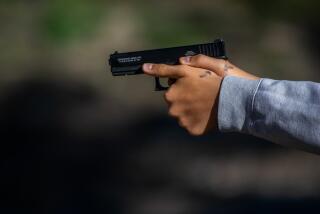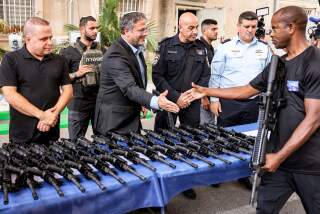Mogadishu’s Hired Guns--a Violent Culture
- Share via
MOGADISHU, Somalia — It was anything but a warm welcome Tuesday afternoon at the Bakara arms bazaar, a dusty road in the heart of Mogadishu lined with rickety wooden stands that offer every known weapon from single bullets to antiaircraft guns.
“You American?” an angry, well-armed Somali teen-ager asked two visiting journalists menacingly.
Within seconds of their nods, guns started blazing, at first in the air in an unmistakable warning.
“Go away!” he added, as the gun barrels lowered. “We hate the Americans here. You want only to take our guns. Get out of here!”
It was a rare moment of confrontation in this otherwise peaceful capital on Monday, as the final hours of the madness that has been Mogadishu ticked away before today’s U.S. Marine landing.
But, in a nation where the gun has been the only national law for almost two years, the warning fire in the vast arms bazaar, which has fed this nation bullets at the expense of its food, was a clear indication of the depth of the culture of violence facing the American forces.
“They would have killed you, I think,” said David, a well-educated Somali who now works as a driver, as he and his own armed escorts sped the journalists away from Bakara bazaar. “When the Marines come, these gun sellers will be too afraid. They will give their guns to the Marines, I think. They will say only to give them some money.
“But you see for yourself now, we Somalis, for two years we are living in this hell. Everyone is afraid to die. So, naturally, the gun becomes the only law.”
That fear clearly had not diminished in the capital on the eve of the Marine landing that most Somalis, like David, were preparing to welcome with open arms and hearts. If anything, that fear grew a bit amid the uncertainty of the coming of a new armed force and the great potential for misunderstanding.
Indeed, international relief officials in the capital issued instructions to their more than 200 expatriate aid workers to remain within their residential compounds for at least 48 hours and to dismiss the thousands of hired gunmen who have attempted to protect them and their humanitarian projects against the insurmountable odds of looting by better-armed gangs.
“We have asked all relief workers to be extremely cautious for the next 48 hours--to keep their movements to an absolute minimum,” said Ian McLeod, an officer for UNICEF. “What we don’t want in the next 24 or 48 hours are guns out on the street.”
But McLeod added that such a task will be difficult, if not impossible. Disarmament, he said, clearly remains at the heart of any successful military mission in Somalia. And he conceded that, in the short term, it will cripple what has become Mogadishu’s most vibrant economic sector: the hired gun.
On the eve of the U.S. Marine landing, hundreds of the heavily armed gangs continued to “patrol” their pieces of battered urban turf in pickup trucks, jeeps and sawed-off Land Rovers, all with mounted, heavy-caliber machine guns.
Most of the hired guns loyal to the city’s top warlords are expected to continue that awesome presence even after the Marine landing, until the U.S.-led forces decide whether--or how--to disarm them and restore order to the city that lies between the airport and seaport.
Still, if any serious move is made to neutralize the deeply fractious and overwhelmingly armed gangs, its result will be as uncertain as the confrontation at the Bakara arms bazaar.
Umer Ali Hassan was a case in point. He spent Tuesday morning as he always has, seated on a long-since-abandoned gas pump with his M-16 assault rifle by his side, guarding the southern checkpoint of the Green Line, which has divided Mogadishu along clan lines since Somalia’s government collapsed in January, 1991.
“Before the war, I was a shopkeeper. I sold clothing,” the otherwise gentle, 38-year-old gunman explained. “Then all of our shops were looted. The government fell, and now I work for the nation.”
Actually, Ali Hassan works for Mohammed Farah Aidid, the powerful warlord who led the armed coalition that drove Somali President Mohamed Siad Barre from power. Aidid then broke with warlord Ali Mahdi Mohamed, the leader of a rival sub-clan.
As for his M-16, the gunman added that he would happily give it up to the Marines, provided that the U.S.-led military force succeeds in providing security for the capital. “I need safety, only,” he said, holding out his rifle. “If we get safety, I will give this to the nation as a gift.”
At the city’s beachfront international airport, the key site that the Marines were assigned as their landing and operations base to bring in the U.S.-led armed force of more than 30,000 international “humanitarian troops,” a gate guard offered a similarly encouraging line.
“I was a soldier before,” said Osman, who is among the scores of armed Somalis hired by the armed Pakistani military force that has been guarding the airport for the past several months. “But after the Marines come, I will give this thing up without hesitation. By now, you see, we hate the gun itself.”
MORE ON SOMALIA: A6-A10
The Weapons at Hand in Somalia
Somalia was flooded with guns by the Soviet Union in the 1970s and by the United States in the 1980s as the superpowers jostled for influence in the Cold War. Dealing with roving bands of gunmen poses one of the trickiest questions for American forces on the ground here.
What Troops Are Taking
* CH-53 Sea Stallion heavy-lift helicopters
* CH-46 Sea Knight medium-lift helicopters
* UH-1 Huey support and logistics helicopters
* AH Cobra attack helicopters
* M-1A1 Abrams tanks
What They May Face
Any trouble American troops encounter will come from a dizzying assortment of mostly outmoded weapons. Among them:
* “Technicals”--Old pickup trucks or jeeps mounted with machine guns. The finished products resemble Mad Max-style vehicles that roam the streets in the capital city.
* AK-47 assault rifles
* M-16 assault rifles
* Small tanks
* Grenade launchers
More to Read
Sign up for Essential California
The most important California stories and recommendations in your inbox every morning.
You may occasionally receive promotional content from the Los Angeles Times.










